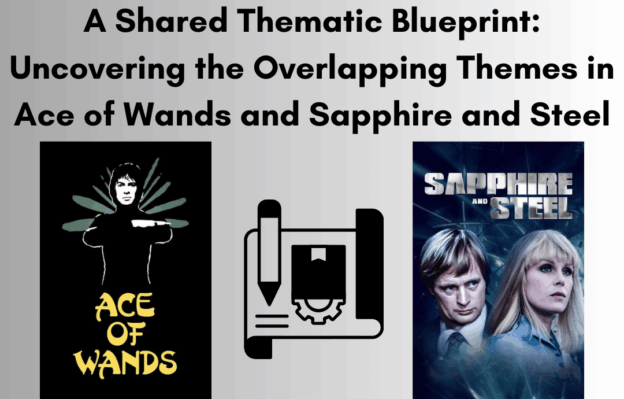At first glance, “Ace of Wands” and “Sapphire and Steel” might seem to occupy different corners of the speculative fiction spectrum. However, a deeper examination reveals a shared thematic terrain that showcases how both series explore similar underlying concerns despite their distinct narrative styles. The following analysis highlights some of these thematic connections, showcasing how both shows are part of a broader conversation within the genre.
- Manipulation of Reality:
- Both series are fundamentally concerned with characters who have the ability to manipulate reality, be it through magical or supernatural means in “Ace of Wands” or through control over temporal and spatial dimensions in “Sapphire and Steel.”
- The act of navigating and altering reality forms the core of many narrative arcs, providing a playground for exploring larger existential and philosophical questions.
- Battle Against Unseen Forces:
- The antagonistic forces in both series often manifest as unseen or abstract entities. Whether it’s malevolent individuals with dark powers in “Ace of Wands” or impersonal cosmic forces in “Sapphire and Steel”, the protagonists are pitched against adversaries that challenge the known laws of reality.
- This thematic choice allows for an exploration of fear of the unknown, a quintessential theme in many speculative fiction narratives.
- Temporal Discontinuity and Past’s Influence:
- Both series touch on the theme of how the past influences the present. In “Ace of Wands”, ancient lore and mystical traditions often play a crucial role in the storylines.
- In “Sapphire and Steel”, the operatives often deal with anomalies rooted in historical events or ancient evils, emphasizing a continuous struggle between past and present.
- Responsibility and Ethical Boundaries:
- Both Tarot and the operatives are endowed with great power, and with it, the narrative suggests, comes a responsibility to use these powers ethically.
- The dilemmas faced by these characters often revolve around the ethical boundaries of their actions, providing a nuanced exploration of the age-old adage, “with great power comes great responsibility.”
- The Thin Veil Between Worlds:
- Lastly, both series illustrate a thin veil between the mundane world and the realms of the supernatural or the unknown. They invite audiences to consider the fragility and the complex interplay of reality, time, and space.
Conclusion
Despite their distinct narrative and stylistic approaches, “Ace of Wands” and “Sapphire and Steel” share a thematic tapestry that explores the manipulation of reality, unseen adversarial forces, the influence of the past, ethical responsibility, and the thin veil between the known and the unknown. Through their respective lenses, they contribute to a broader thematic exploration within speculative fiction, making them thematically kindred spirits within the genre.
